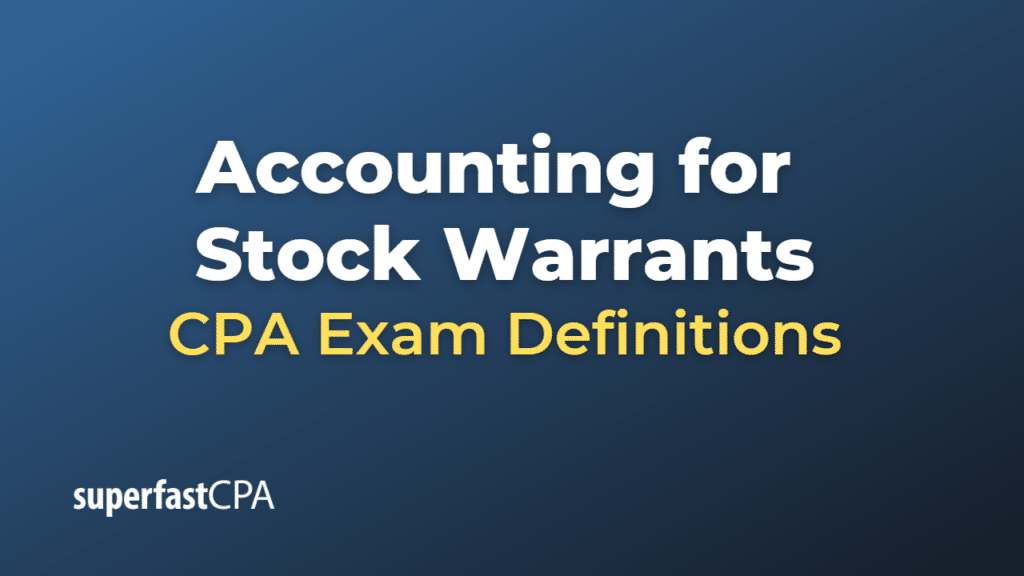Accounting for Stock Warrants
Accounting for stock warrants involves the identification, recognition, measurement, and disclosure of warrants issued by a company. A stock warrant is a financial instrument that gives the holder the right to purchase a company’s stock at a specified price, known as the exercise or strike price, within a specified period. Warrants are often issued in conjunction with other securities, such as bonds or preferred stock, as a form of “sweetener” to make the investment more attractive.
Under U.S. Generally Accepted Accounting Principles (GAAP), accounting for stock warrants is primarily governed by the Financial Accounting Standards Board (FASB) Accounting Standards Codification (ASC) Topic 470-20, “Debt with Conversion and Other Options,” and ASC Topic 815, “Derivatives and Hedging.
Here are the key aspects of accounting for stock warrants:
- Identification: Determine if a financial instrument qualifies as a stock warrant. Stock warrants are typically issued as detachable or non-detachable instruments, giving the holder the right to purchase a company’s stock at a specified price within a specified period.
- Classification: Stock warrants can be classified as equity or liability instruments, depending on their terms and conditions. Equity-classified warrants typically have fixed terms and are settled by issuing a fixed number of the company’s common shares. Liability-classified warrants may have variable terms or be settled in cash or other assets.
- Recognition: Recognize the stock warrant as an equity or liability instrument in the financial statements, based on its classification.
- Measurement: Equity-classified warrants are typically measured at their fair value on the issuance date and are not subsequently re-measured. Liability-classified warrants are measured at fair value on the issuance date and are re-measured at fair value at each subsequent reporting date, with changes in fair value recognized in the income statement.
- Presentation: Equity-classified warrants are presented as a separate component of stockholders’ equity in the balance sheet, while liability-classified warrants are presented as a liability.
- Disclosure: Companies should provide clear and concise information about their accounting policies for stock warrants in the notes to the financial statements. This may include information about the terms and conditions of the warrants, their classification, and the methods used to measure their fair value.
By properly accounting for stock warrants, a company provides users of its financial statements with an accurate representation of its financial position and performance, considering the potential dilution or financial obligations associated with the issuance of the warrants.
Example of Accounting for Stock Warrants
Let’s consider an example of a company accounting for stock warrants.
Example: Company XYZ issues 1,000 bonds with a face value of $1,000 each, for a total of $1,000,000. To make the bonds more attractive to investors, Company XYZ attaches one detachable stock warrant to each bond. Each warrant gives the bondholder the right to purchase one share of Company XYZ’s common stock at an exercise price of $20 per share. The warrants have a 5-year term.
Here’s how Company XYZ would account for the stock warrants:
Step 1:
Identification: The financial instruments issued by Company XYZ qualify as stock warrants.
Step 2:
Classification: The stock warrants have fixed terms and are settled by issuing a fixed number of the company’s common shares. Therefore, they are classified as equity instruments.
Step 3:
Recognition: Company XYZ recognizes the stock warrants as equity instruments in its financial statements.
Step 4:
Measurement: The fair value of the stock warrants on the issuance date is determined using an appropriate valuation method, such as the Black-Scholes option pricing model. Assume the fair value of each warrant is $5. Since there are 1,000 warrants, the total fair value of the warrants is $5,000. Company XYZ allocates the proceeds from the bond issuance between the bonds and the warrants based on their relative fair values. In this case, the total proceeds of $1,000,000 would be allocated as follows:
| Bonds: ($1,000,000 / $1,005,000) × $1,000,000 = $995,024.88 |
| Warrants: ($5,000 / $1,005,000) × $1,000,000 = $4,975.12 |
The warrants are measured at their fair value of $4,975.12 and are not subsequently re-measured.
Step 5:
Presentation: Company XYZ presents the stock warrants as a separate component of stockholders’ equity in the balance sheet.
| Additional paid-in capital – stock warrants: $4,975.12 |
Step 6:
Disclosure: Company XYZ provides information about its accounting policies for stock warrants in the notes to the financial statements, including the terms and conditions of the warrants, their classification, and the methods used to measure their fair value.
By properly accounting for stock warrants, Company XYZ provides users of its financial statements with an accurate representation of its financial position and performance, considering the potential dilution associated with the issuance of the warrants.













